Adhering to Studio Template
- litterblocks
- Posts: 5
- Joined: 29 Dec 2015, 07:38
Adhering to Studio Template
All storyboards must adhere to a template created by the studio I work for. Is there a way to put this template into TVPaint?
Here's a rough example of the final output. I'd like the camera moves of clips etc to be independent of this dialogue and border.
http://imgur.com/JRFpWDU" onclick="window.open(this.href);return false;
In Flash, I create a document matching the template final size, then re-create the border/dialogue boxes on separate layers in the main timeline. Beneath those layers, I have one layer called "Shots". Each new symbol/keyframe is a 'shot' similar to how TVPaint has 'clips'. I only animate camera moves on the main timeline. This way no matter what changes in the shot, it's always adherent to the template.
Is there a way to re-create this workflow in TVPaint?
Here's a rough example of the final output. I'd like the camera moves of clips etc to be independent of this dialogue and border.
http://imgur.com/JRFpWDU" onclick="window.open(this.href);return false;
In Flash, I create a document matching the template final size, then re-create the border/dialogue boxes on separate layers in the main timeline. Beneath those layers, I have one layer called "Shots". Each new symbol/keyframe is a 'shot' similar to how TVPaint has 'clips'. I only animate camera moves on the main timeline. This way no matter what changes in the shot, it's always adherent to the template.
Is there a way to re-create this workflow in TVPaint?
- D.T. Nethery
- Posts: 4244
- Joined: 27 Sep 2006, 19:19
Re: Adhering to Studio Template
I think you could do more or less the same thing in TVPaint , create the border/dialogue boxes on separate layers in the main timeline (as an overlay) and draw the storyboard panels on layers underneath , so the storyboard panels fit inside the template border.litterblocks wrote:All storyboards must adhere to a template created by the studio I work for. Is there a way to put this template into TVPaint?
Here's a rough example of the final output. I'd like the camera moves of clips etc to be independent of this dialogue and border.
http://imgur.com/JRFpWDU" onclick="window.open(this.href);return false;
In Flash, I create a document matching the template final size, then re-create the border/dialogue boxes on separate layers in the main timeline. Beneath those layers, I have one layer called "Shots". Each new symbol/keyframe is a 'shot' similar to how TVPaint has 'clips'. I only animate camera moves on the main timeline. This way no matter what changes in the shot, it's always adherent to the template.
Is there a way to re-create this workflow in TVPaint?
First create and save your Storyboard Template as a separate TVPaint project like this:
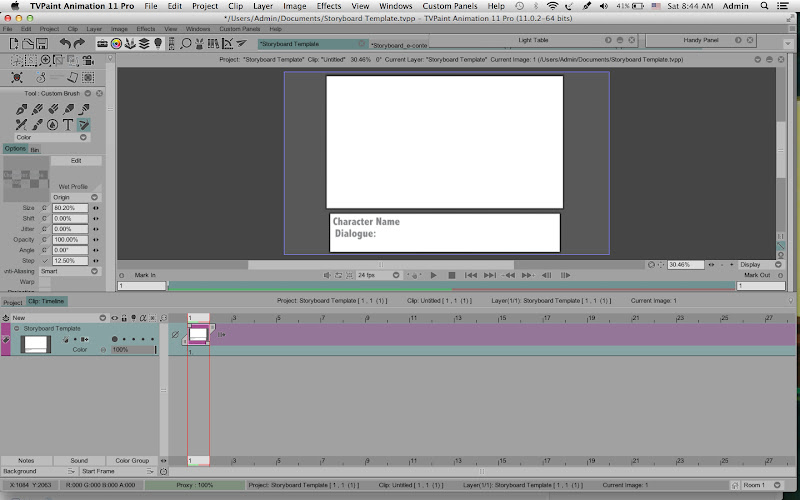
Then you can have that Storyboard Template project open at the same time you work on your storyboard/animatic project and simply copy & paste that saved Storyboard Template layer into each new Clip you create in the continuity of your storyboard/animatic ... OR you could reference the Storyboard Template layer on a new layer in each clip using the KeyFramer FX Tool (in the KeyFramer the "Source" would be set to your Storyboard Template project ).
So an individual Clip would look like this , with the Storyboard Template overlay held on the top layer over the entire length of the Clip -
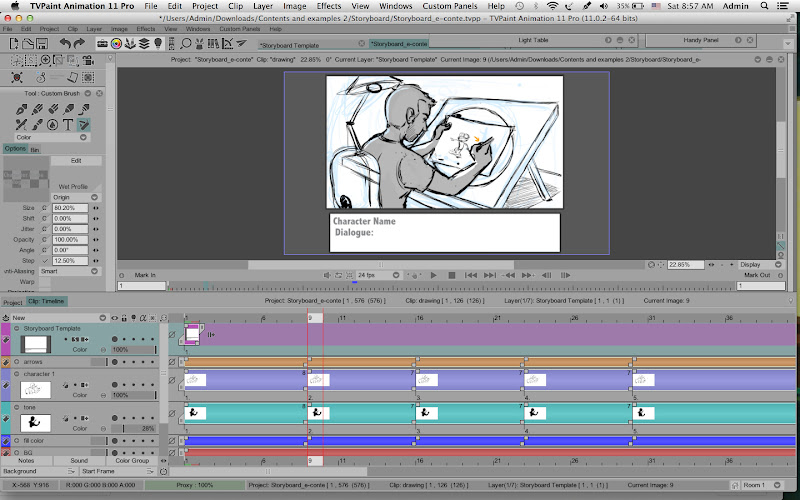
Here is each Clip (scene) as viewed in continuity in the Project timeline -
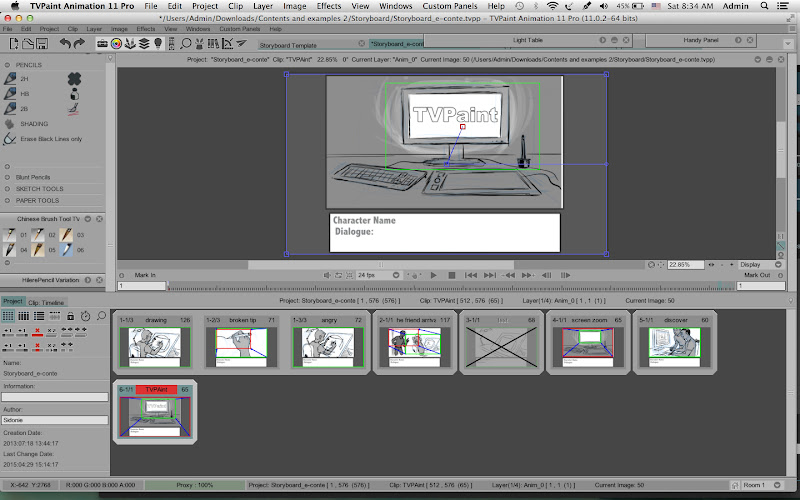
The main difference in workflow might be this:
The Camera Tool in TVPaint applies the camera moves to each Clip , so each clip can have it's own set of camera moves (or no moves as needed) . So when your render the entire Project (all Clips in continuity) to an animatic movie file , you would render with "Camera View" enabled in the Export panel, so only what is within the Camera View in each Clip will be rendered to the animatic movie file .I only animate camera moves on the main timeline. This way no matter what changes in the shot, it's always adherent to the template.
For example this is what you would see in the original TVPaint project file:

But rendered to an animatic with Camera View , this is what you would see when viewing the animatic :
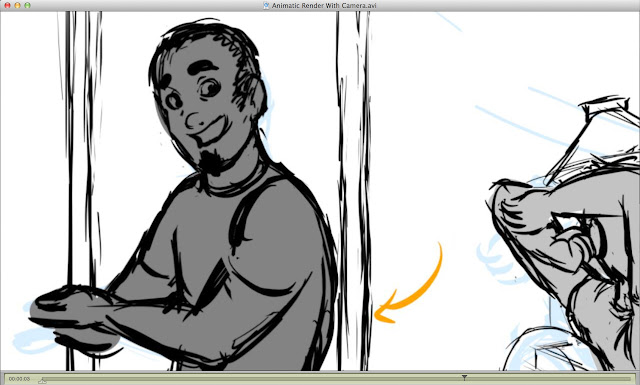
So, I'm not exactly sure if that is what you want ?
---------
A different approach , using the KeyFramer Tool in the FX Stack -
If you wanted the entire Template frame to show (including the Dialogue box underneath the main frame) in the animatic , then you could render the camera moves using the KeyFramer Tool in the FX Stack . In this workflow the Storyboard Template is an overlay on top of the storyboard panel(s) layer(s) as shown previously , but in this case use the KeyFramer Tool to apply the camera moves to the storyboard panels but the Storyboard Template frame stays static , so the template frame is like a "window" you are looking through at the scene beyond the window .
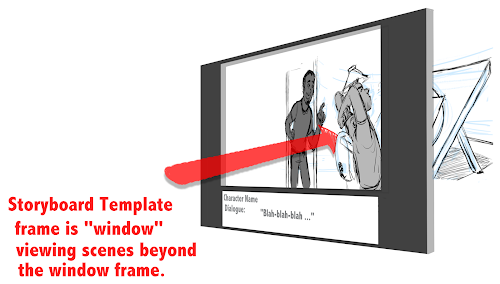
In these two screen captures notice in the first screen capture the numbers in the X-Y-Z coordinates of the KeyFramer at the start and then in the second screen capture notice that numbers in the X-Y-Z coordinates at the end of the move are different . You create the camera move on the artwork by changing these coordinates and setting KeyFrames (the little + marks ) to control the duration of the move. (you can also use the Time Profile editor in the KeyFramer Tool to add slow-in and slow-out at the start and end of a move) .
Here's the start of the clip, without the KeyFramer applied yet:
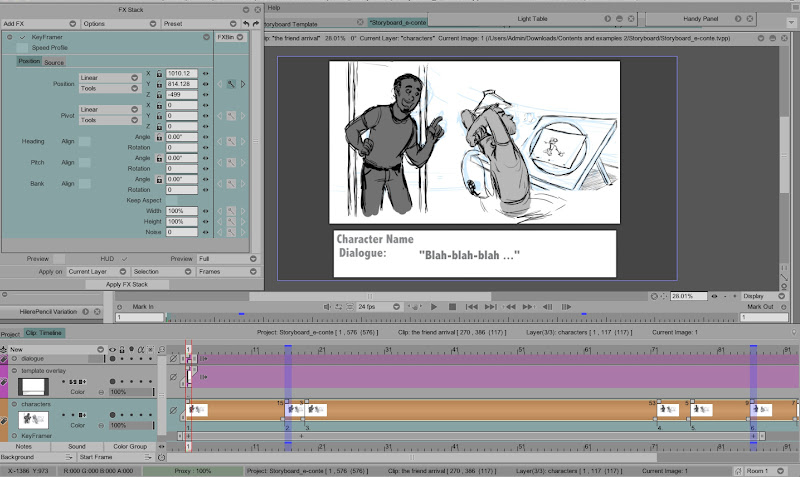
Starting camera position, KeyFramer coordinates - X=1010.12 , Y=814.128 , Z= - 499
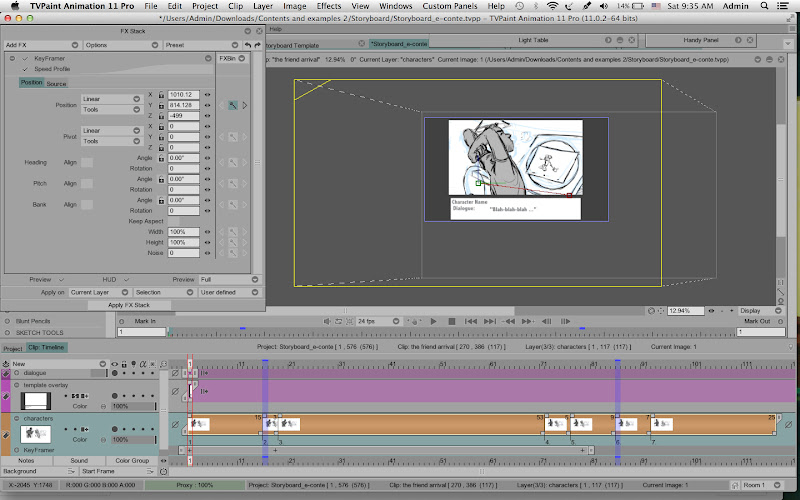
Midway position through the camera move - (notice KeyFramer coordinates changing and progress along path-of-action line)
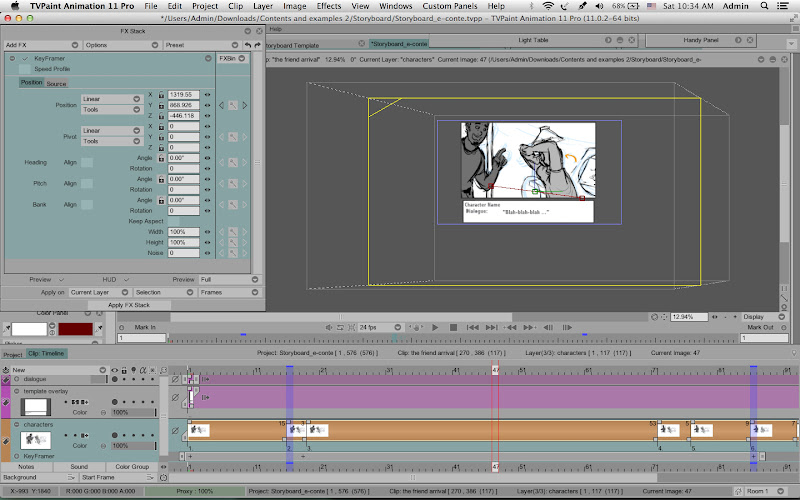
End camera position, KeyFramer coordinates - X=1735.68 , Y=942.64 , Z= - 375
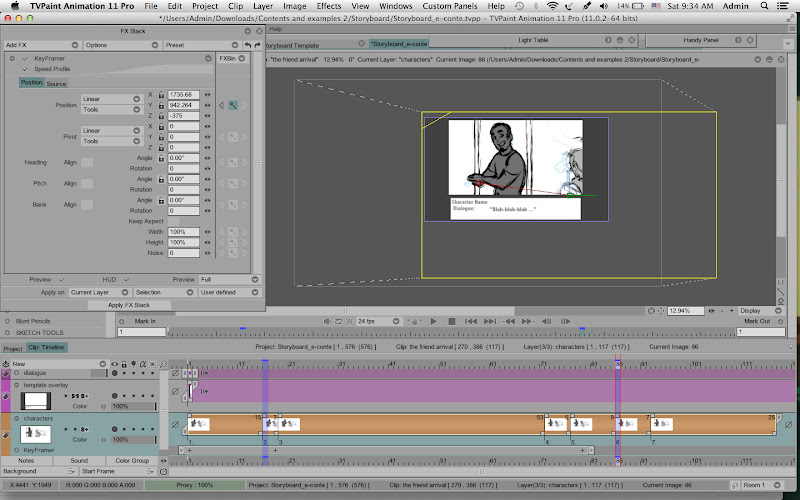
You can preview the KeyFramer move by hitting the Playback button . When you are satisfied with the move , select all frames and Apply FX to render the move on the storyboard panel layer . (if you have more than one layer you simply move down to that next layer and re-apply the same KeyFramer FX and repeat ... or if have Merged all the layers you just have to apply the KeyFramer FX move one time. )
Then when you render this project to an animatic movie you set the Export to Project View (NOT Camera View) , so you will see the entire Storyboard Template frame (including the Dialogue box) rendered in the animatic, as in this sample clip -
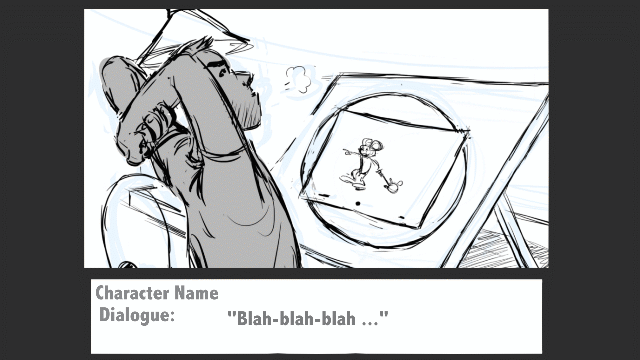
(Attached Quicktime movie plays smoother than the embedded .gif)
.
- Attachments
-
- Animatic_SCENE 4_export.mov
- (1.28 MiB) Downloaded 1270 times
Last edited by D.T. Nethery on 16 Jan 2016, 17:53, edited 3 times in total.
Animator, TVPaint Beta-Tester, Animation Educator and Consultant.
TVPaint PRO 11.7.4 - 64bit
MacOS 12.7.1 Monterey ,
Mac Mini (2018) , 3.2 GHz 6-Core Intel Core i7, 16 GB RAM ,
XP-Pen Artist Pro 19 (Gen 2) 4K,
TVPaint PRO 11.7.4 - 64bit
MacOS 12.7.1 Monterey ,
Mac Mini (2018) , 3.2 GHz 6-Core Intel Core i7, 16 GB RAM ,
XP-Pen Artist Pro 19 (Gen 2) 4K,
- D.T. Nethery
- Posts: 4244
- Joined: 27 Sep 2006, 19:19
Re: Adhering to Studio Template
Keep in mind you can PUBLISH your storyboard to a PDF .
File menu > Publish ... . http://www.tvpaint.com/doc/tvp11/index. ... ublish-pdf" onclick="window.open(this.href);return false;
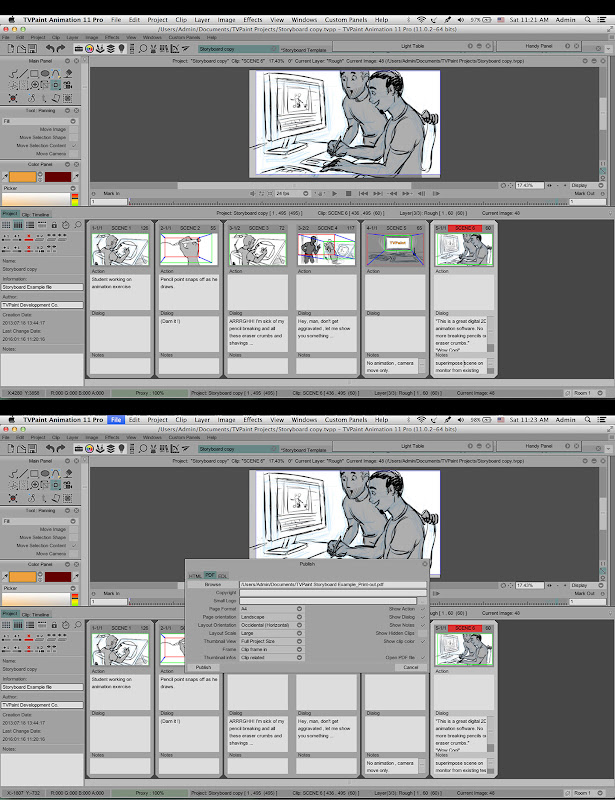
Here's an example of what it looks like in PDF format -
(click on image to see it larger)
File menu > Publish ... . http://www.tvpaint.com/doc/tvp11/index. ... ublish-pdf" onclick="window.open(this.href);return false;

Here's an example of what it looks like in PDF format -
(click on image to see it larger)
Animator, TVPaint Beta-Tester, Animation Educator and Consultant.
TVPaint PRO 11.7.4 - 64bit
MacOS 12.7.1 Monterey ,
Mac Mini (2018) , 3.2 GHz 6-Core Intel Core i7, 16 GB RAM ,
XP-Pen Artist Pro 19 (Gen 2) 4K,
TVPaint PRO 11.7.4 - 64bit
MacOS 12.7.1 Monterey ,
Mac Mini (2018) , 3.2 GHz 6-Core Intel Core i7, 16 GB RAM ,
XP-Pen Artist Pro 19 (Gen 2) 4K,
Re: Adhering to Studio Template
Thanks for the detailled answer David
I just want to add that one can decide to keep the "dialogue" box only when publishing the PDF.
I just want to add that one can decide to keep the "dialogue" box only when publishing the PDF.
Fabrice Debarge
- D.T. Nethery
- Posts: 4244
- Joined: 27 Sep 2006, 19:19
Re: Adhering to Studio Template
Well , at least the detailed answer is there for anyone searching the forum for such information ... the original poster , litterblocks, seems to have lost interest in finding out the answer to his/her question ...Fabrice wrote:Thanks for the detailed answer David
I just want to add that one can decide to keep the "dialogue" box only when publishing the PDF.
Animator, TVPaint Beta-Tester, Animation Educator and Consultant.
TVPaint PRO 11.7.4 - 64bit
MacOS 12.7.1 Monterey ,
Mac Mini (2018) , 3.2 GHz 6-Core Intel Core i7, 16 GB RAM ,
XP-Pen Artist Pro 19 (Gen 2) 4K,
TVPaint PRO 11.7.4 - 64bit
MacOS 12.7.1 Monterey ,
Mac Mini (2018) , 3.2 GHz 6-Core Intel Core i7, 16 GB RAM ,
XP-Pen Artist Pro 19 (Gen 2) 4K,
Re: Adhering to Studio Template
yup, always difficult to know if the people with 1 ou 2 posts are serious and will come back to read answers & continue the discussion. 
Fabrice Debarge
- Jourdan Biziou
- Posts: 23
- Joined: 09 Jan 2016, 21:03
- Location: Los Angeles, CA
Re: Adhering to Studio Template
I think this is all very good information ! 
~ I think therefore I draw ~
Win 7 64bit, Nvidia Quadro K5000, 34 GB. TVpaint 11.0 pro 64bit, Wacom Cintiq 27 HD, Intuos 3
Win 7 64bit, Nvidia Quadro K5000, 34 GB. TVpaint 11.0 pro 64bit, Wacom Cintiq 27 HD, Intuos 3
- NathanOtano
- Posts: 1225
- Joined: 01 Apr 2014, 07:07
- Location: Biarritz, France
- Contact:
Re: Adhering to Studio Template
Yup, your explanation helped me too, really usefull. So thanks a lot 
Working on Windows 10
Creator of Disnosc, providing storyboard, animation and design for 2D realistic pictural animation: https://www.disnosc.fr/ - nathanotano@disnosc.fr
Highly interested in animation workflows, I'm open to scripting new TVP functions for individuals and studios.
Creator of Disnosc, providing storyboard, animation and design for 2D realistic pictural animation: https://www.disnosc.fr/ - nathanotano@disnosc.fr
Highly interested in animation workflows, I'm open to scripting new TVP functions for individuals and studios.
- litterblocks
- Posts: 5
- Joined: 29 Dec 2015, 07:38
Re: Adhering to Studio Template
Interest definitely not lost! I apologize for the incredibly long delay in replying. I suppose that's a small window into how little downtime I get into learning a new software (and why I want something faster...catch 22).
I am exploring these options right now (finally).
The 'window' option looks closest to how I currently work. The initial flags that go up for me are perhaps the amount of copy/pasting? Not just for the repetitiveness of it but it leaves a lot of chance for misalignment/human error when things are moving quickly as they normally are.
In flash I just create a layer for each:
FLASH MAIN TIMELINE LAYERS
- Dialogue (new keyframe for each change in dial)
- Gray dialogue Box
- Black frame
- STAGE (symbols containing actual scenes, and where camera moves are done).
I wouldn't be able to use the TVP dialogue/action window templates or PDF as they don't match the templates specified by the studio, and I've found that most places have a very specific template they require adherence to so there's no feathers ruffled going to and from editorial departments. They don't normally mind what tools we use so long as the final storyboards match their template precisely.
I'll post my findings as I explore these options if it helps? Again, I feel terrible if you think I didn't appreciate the in depth feedback and just wanted to at least let you know that I was definitely using it! Thank you very very very much!
I am exploring these options right now (finally).
The 'window' option looks closest to how I currently work. The initial flags that go up for me are perhaps the amount of copy/pasting? Not just for the repetitiveness of it but it leaves a lot of chance for misalignment/human error when things are moving quickly as they normally are.
In flash I just create a layer for each:
FLASH MAIN TIMELINE LAYERS
- Dialogue (new keyframe for each change in dial)
- Gray dialogue Box
- Black frame
- STAGE (symbols containing actual scenes, and where camera moves are done).
I wouldn't be able to use the TVP dialogue/action window templates or PDF as they don't match the templates specified by the studio, and I've found that most places have a very specific template they require adherence to so there's no feathers ruffled going to and from editorial departments. They don't normally mind what tools we use so long as the final storyboards match their template precisely.
I'll post my findings as I explore these options if it helps? Again, I feel terrible if you think I didn't appreciate the in depth feedback and just wanted to at least let you know that I was definitely using it! Thank you very very very much!
Re: Adhering to Studio Template
Never be sorry about giving feedbacks here ! That's how the software has always been evolving 
I had similar feedbacks this week about the storyboard engine, so there is defenitely something to work on and be more efficient in the animation industry.
I had similar feedbacks this week about the storyboard engine, so there is defenitely something to work on and be more efficient in the animation industry.
- litterblocks
- Posts: 5
- Joined: 29 Dec 2015, 07:38
Re: Adhering to Studio Template
This is unfortunately seeming like a dealbreaker. The above mentioned solutions do work but there's a lot of extra steps involved that will not only slow down how I currently work, but add more potential for error as well if I forget to properly adjust the framing. Also, working in Flash(AnimateCC), I can create a text field for dialogue that I just click into in order to enter the text for that keyframe, w/o worrying how it aligns in each instance.
It would be amazing if there was some kind of custom framing/dialogue format that automatically goes over the scene, utilizing the existing dialogue input system. Unfortunately, without that I wont be able to use this effectively enough. I really do appreciate all the feedback on this, at least I wont be haunted by wondering if this could have worked. Thanks again, I hope it at least helps someone else or if it changes I'll be checking in for that too!
It would be amazing if there was some kind of custom framing/dialogue format that automatically goes over the scene, utilizing the existing dialogue input system. Unfortunately, without that I wont be able to use this effectively enough. I really do appreciate all the feedback on this, at least I wont be haunted by wondering if this could have worked. Thanks again, I hope it at least helps someone else or if it changes I'll be checking in for that too!
Re: Adhering to Studio Template
And thank you for your feedbacks, they will be very helpful to improve the storyboard engine !
- litterblocks
- Posts: 5
- Joined: 29 Dec 2015, 07:38
Re: Adhering to Studio Template
I'll stay tuned then! Still really interested in TVPaint as an option.
